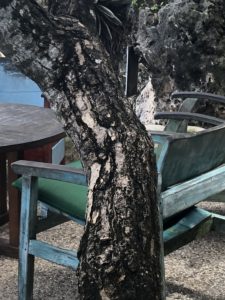
“The way you sit and stand are psychological positions as well as a physical ones. Its worth doing them consciously.”
Here are three simple ways to centre yourself while sitting. You can practise them individually or together, one after the other. Each of them has a slightly different effect and benefit, all of them are simple and easy to do once you have tried them a few times. They are designed to encourage a feeling in the body that is helpful both to our physical health and energy levels as well as our psychological wellbeing. They can be done standing as well as sitting.
Position 1 – Sitting like a puppet: Sit upright in a chair, imagine that you have a piece of string attached to the crown of your head. Feel it pulling your head neck and torso up a couple of centimetres, so that your posture is upright and vertical. Now imagine you are hanging from the string. Relax all the muscles in the body as much as you can, so that the only muscle work that your body is doing is to keep itself upright. For example, your face does not need to hold any tension for the body to be upright. Progressively go through all the main areas of your body, relaxing them as much as possible. Then simply notice what this feels like, focusing your attention on it for a while.
Often when we are sitting or standing we are holding a lot of unnecessary tension in our body, the idea here is to create a habitual way of sitting that is ergonomic as well as relaxing.
Position 2 – The half-smile: Become aware of the expression on your face. Spend a few moments relaxing the muscles in the face and bringing it into a neutral expression. Then raise the corners of your mouth a few millimetres so that your expression describes a warm half-smile. As you breathe in, focus on the feeling of the expression, as you breathe out, extend the feeling of the expression to the rest of your body, and if you like to any moods, emotions or thoughts in your mind. Centre yourself around your facial expression for a short while, being curious about the effect that it has on you.
Its very easy to spend long periods of the day with holding tension and emotion in our expression that are not helping us. The half-smile helps us to counter this tendency.
Position 3 – Sitting with confidence: The half-smile expression already invites a feeling of gentle self-confidence. Becoming more aware of the body, make small adjustments that help you connect to a feeling of confidence. Even if you don’t feel immediately confident, adopt a posture that helps you start to move that way; shoulders and chest open and relaxed, hands and limbs relaxed. Like the other two positions, practice the posture so that the body becomes familiar with it, and it becomes a habitual, default body posture for you, even when you are under pressure.
So, there you go, three body positions to practice centring yourself mindfully around anytime!
Article and picture © Toby Ouvry 2019, you are welcome to use or share this article, but please cite Toby as the source and include reference to his website www.tobyouvry.com
Shadow Coaching with Toby February Special Offer
Special offer of 15% off Toby’s shadow coaching 3 session package up to end Thursday 14th February. for full details click HERE!
“One does not become enlightened by imagining figures of light, but by making the darkness conscious.” – Carl Jung
All Courses at Integral Meditation Asia for February
Ongoing on Wednesday’s, 7.30-8.30pm – Wednesday Meditation Classes at Basic Essence with Toby
Ongoing on Tuesday evenings, 7.30-8.30pm – Tuesday Meditation Classes at One Heart with Toby (East coast)
Monday 6.15-7.15 & Wednesday 12.15-1.15 – Integral Meditation classes at Space2B on Stanley Street
Saturday mornings 9-10.15am, 16th & 23rd February – Qi Gong workout and meditation class
Tues & Weds February 12/13th – Monthly astrological meditation – Aquarius: Developing your inner knowing and self-knowledge
Saturday 23rd February 11-12.30pm – Get your meditation practice started now- The shortest and most time effective meditation workshop ever
Saturday 23rd February, 3.30-5.30pm – Developing Your Self-Confidence Through Mindfulness Workshop
Integral Meditation Asia
Online Courses * 1:1 Coaching * Books * Live Workshops * Corporate Mindfulness Training *Life-Coaching * Meditation Technology
 Unstructured mindfulness – Turning and facing yourself
Unstructured mindfulness – Turning and facing yourself


 Dimensions of mindful perception and understanding
Dimensions of mindful perception and understanding




